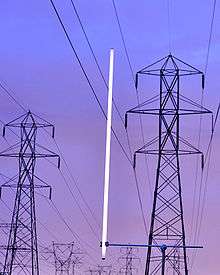Capacitive coupling
Capacitive coupling is the transfer of energy within an electrical network or between distant networks by means of displacement current between circuit(s) nodes, induced by the electric field. This coupling can have an intentional or accidental effect.

In its simplest implementation, capacitive coupling is achieved by placing a capacitor between two nodes.[1] In its general form the coupling is described by a capacitance matrix Cij. Where Cii are self-capacitance coefficients and Cij i≠j are mutual capacitance coefficients.
Use in analog circuits

In analog circuits, a coupling capacitor is used to connect two circuits such that only the AC signal from the first circuit can pass through to the next while DC is blocked. This technique helps to isolate the DC bias settings of the two coupled circuits. Capacitive coupling is also known as AC coupling and the capacitor used for the purpose is also known as a DC-blocking capacitor.
A coupling capacitor's ability to prevent a DC load from interfering with an AC source is particularly useful in Class A amplifier circuits by preventing a 0 volt input being passed to a transistor with additional resistor biasing; creating continuous amplification.
Capacitive coupling has the disadvantage of degrading the low frequency performance of a system containing capacitively coupled units. Each coupling capacitor along with the input electrical impedance of the next stage forms a high-pass filter and the sequence of filters results in a cumulative filter with a −3dB frequency that may be higher than those of each individual filter. So for adequate low frequency response, the capacitors used must have high capacitance ratings. They should be high enough that the reactance of each is at most a tenth of the input impedance of each stage, at the lowest frequency of interest. See Impedance bridging.
Coupling capacitors can also introduce nonlinear distortion at low frequencies. This is not an issue at high frequencies because the voltage across the capacitor stays very close to zero. However, if a signal is allowed to pass through the coupling that is low relative to the RC cutoff frequency, voltages can develop across the capacitor, which for some capacitor types results in changes of capacitance, leading to distortion. This is avoided by choosing capacitor types that have low voltage coefficient, and by using large values that put the cutoff frequency far lower than the frequencies of the signal.[2][3]
These disadvantages of capacitively coupling DC-biased transistor amplifier circuits are largely minimized in directly coupled designs.
Use in digital circuits
AC coupling is also widely used in digital circuits to transmit digital signals with a zero DC component, known as DC-balanced signals. DC-balanced waveforms are useful in communications systems, since they can be used over AC-coupled electrical connections to avoid voltage imbalance problems and charge accumulation between connected systems or components.
For this reason, most modern line codes are designed to produce DC-balanced waveforms. The most common classes of DC-balanced line codes are constant-weight codes and paired-disparity codes.
Gimmick loop
A gimmick loop is a simple type of capacitive coupler: two closely spaced strands of wire. It provides capacitive coupling of a few picofarads between two nodes. Sometimes the wires are twisted together for physical stability.[4][5]
Parasitic capacitive coupling
Capacitive coupling is often unintended, such as the capacitance between two wires or PCB traces that are next to each other. Often one signal can capacitively couple with another and cause what appears to be noise. To reduce coupling, wires or traces are often separated as much as possible, or ground lines or ground planes are run in between signals that might affect each other, so that the lines are capacitively coupled to ground rather than each other. Breadboards are particularly prone to these issues due to the long pieces of metal that line every row creating a several-picofarad capacitor between lines. To prototype high-frequency (10s of MHz) or high-gain analog circuits, often the circuits are built over a ground plane so that the signals couple to ground more than to each other. If a high-gain amplifier's output capacitively couples to its input it often becomes an electronic oscillator.
One rule of thumb says that drivers should be able to drive 25 pF of capacitance which allows for PCB traces up to 0.30 meters.[6]
See also
References
- ↑ Joffe, Elya (2010). Grounds for Grounding:A Circuit to System Handbook. Wiley-IEEE. p. 277. ISBN 0-471-66008-6.
- ↑ "Capacitor Characteristics". sound.westhost.com. Retrieved 2015-06-06.
- ↑ Caldwell, John. "Signal distortion from high-K ceramic capacitors". Retrieved 2015-06-06.
- ↑ Bernard Grob and Milton Sol Kiver (1960). Applications of Electronics. McGraw–Hill. pp. 300–01.
- ↑ Forrest M. Mims (2000). The Forrest Mims Circuit Scrapbook. Newnes. pp. 95–96. ISBN 1-878707-48-5.
- ↑ Media Independent Interface#Signal levels
 This article incorporates public domain material from the General Services Administration document "Federal Standard 1037C" (in support of MIL-STD-188).
This article incorporates public domain material from the General Services Administration document "Federal Standard 1037C" (in support of MIL-STD-188).
External links
- Capacitance and Uses of Capacitors
- Howard Johnson: When to use AC coupling, DC Blocking Capacitor Value
- Texas Instruments: AC-Coupling Between Differential LVPECL, LVDS, HSTL, and CML (PDF)